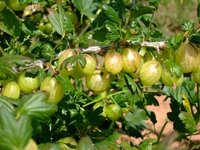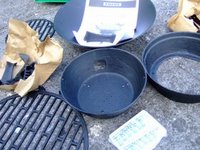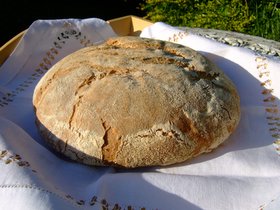 It’s so easy to get sidetracked. I wanted to write about a
It’s so easy to get sidetracked. I wanted to write about a I noticed that several recipes for scones suggest you use buttermilk. I’ve never done that, but it makes a lot of sense as the acid will encourage the raising agent to work better. We no longer use much buttermilk in this country, although we used to. I know about it mainly from soda bread, and in parts of the country it is easy to get, in other parts of the country impossible. I did find some locally, but just as I was about to start in on the scones I found a site that told me how to make my own buttermilk. The process is known as ‘clabbering’ as what you are aiming to make is ‘clabbered’ milk. Any method called clabbering just begs to be tried. The word ‘clabber’ comes from the Irish word for thickened or the Scots word for mud, whichever you like, and the Irish word for milk is banne (see the invaluable MacBain’s Dictionary). Together they make up the word ‘bonnyclabber’, which is what we know as buttermilk.
 You can make buttermilk from scratch with milk that has soured all by itself. If you ever have milk in the fridge that has gone off, with no trace of mould, you can use that, but I didn’t want to hang around that long. In which case you take 6-8 ozs of cultured buttermilk, put it in a scrupulously clean jar and fill up with whole milk. I expect you can do this with skimmed milk too, but I used whole milk.
You can make buttermilk from scratch with milk that has soured all by itself. If you ever have milk in the fridge that has gone off, with no trace of mould, you can use that, but I didn’t want to hang around that long. In which case you take 6-8 ozs of cultured buttermilk, put it in a scrupulously clean jar and fill up with whole milk. I expect you can do this with skimmed milk too, but I used whole milk.
Leave in a warm place(around 69ºF is best) for 24 hours, by which time the milk should have soured and thickened, or clabbered. Ben Jonson mentions ‘bonnyclapper’ as a drink with beer and buttermilk, but I‘m not sure I like the sound of that – and anyway I don’t know what kind of beer Ben was drinking in the 17th century (but it would be interesting to find out…) Buttermilk keeps for weeks at a time in the fridge.
So, with thoroughly clabbered milk we can get back to the scones.
Buttermilk scones
Preheat oven to 200ºC/400ºF/Gas 6.
225g plain flour
1 level tsp bicarbonate of soda
¼ tsp salt
45g unsalted butter
1 tbsp golden caster sugar
About 185 ml buttermilk
 Sift flour, bicarbonate of soda and salt into bowl. Rub in the butter but don’t overwork the mixture, it releases the gluten in the flour which will give a rubbery consistency. Make a well in the centre and add the sugar and enough buttermilk to make a soft dough. Roll out on a floured surface (gently) to a thickness of 1.5cm and use a 5cm cutter to stamp out rounds. Lay on a floured baking sheet and brush tops with milk. Bake for 10 mins until risen and browned.
Sift flour, bicarbonate of soda and salt into bowl. Rub in the butter but don’t overwork the mixture, it releases the gluten in the flour which will give a rubbery consistency. Make a well in the centre and add the sugar and enough buttermilk to make a soft dough. Roll out on a floured surface (gently) to a thickness of 1.5cm and use a 5cm cutter to stamp out rounds. Lay on a floured baking sheet and brush tops with milk. Bake for 10 mins until risen and browned.
Eat warm and fresh, with strawberry jam and clotted cream, for a real taste of the West of England in summer.
















